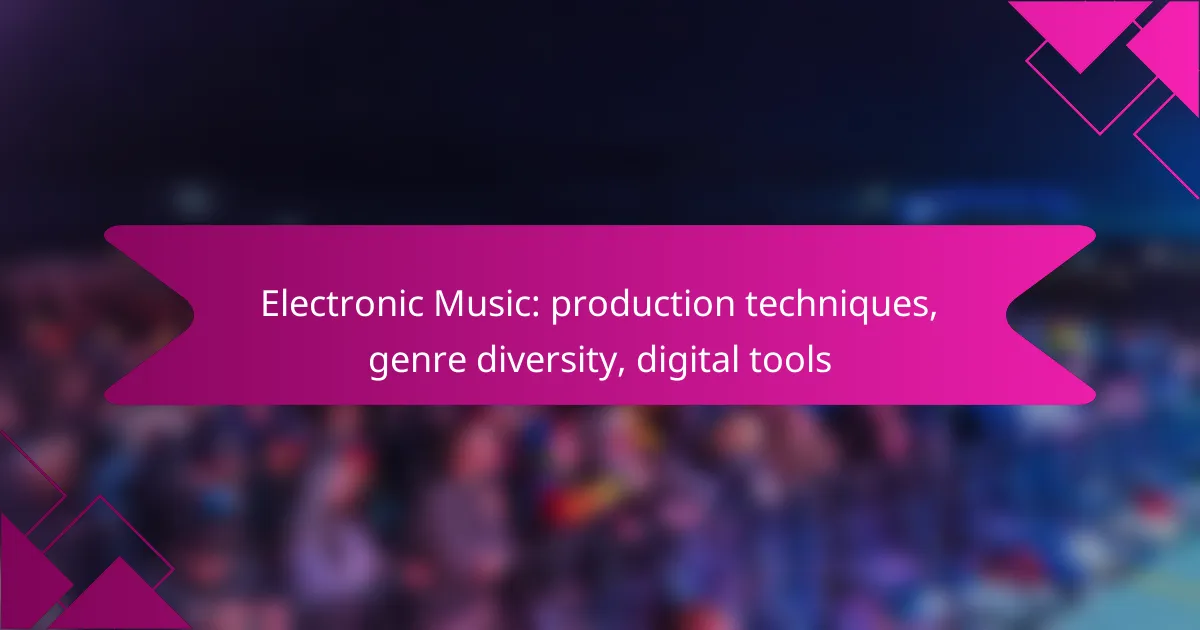Electronic music production is a dynamic field that combines innovative techniques and diverse genres to create captivating soundscapes. By mastering digital audio workstations, MIDI controllers, and sampling methods, producers can craft unique compositions that reflect their artistic vision. With genres like house, techno, and dubstep continually evolving, the use of essential digital tools such as VST plugins and audio interfaces is crucial for achieving high-quality results in music creation.

How to produce electronic music effectively?
Producing electronic music effectively involves mastering various tools and techniques to create unique sounds and compositions. Focus on using digital audio workstations, incorporating MIDI controllers, layering sounds, and utilizing sampling to enhance your music production.
Using digital audio workstations like Ableton Live
Digital audio workstations (DAWs) like Ableton Live are essential for electronic music production. They provide a platform to record, edit, and arrange your music, allowing for flexibility and creativity. Familiarize yourself with the interface and features, such as clip launching and audio effects, to maximize your productivity.
When starting, consider using templates or pre-made projects to understand the workflow. Experiment with different audio effects and instruments available in the DAW to find your unique sound. Regularly save your work and use version control to track changes and improvements.
Incorporating MIDI controllers for live performance
MIDI controllers enhance live performances by allowing musicians to manipulate sounds in real-time. These devices can range from simple keyboard controllers to complex pads and mixers. Choose a MIDI controller that suits your performance style and integrates well with your DAW.
During live sets, use the MIDI controller to trigger samples, adjust effects, and control virtual instruments. Practice your set to ensure smooth transitions and familiarize yourself with the controller’s layout. Avoid overloading your setup with too many devices, which can complicate your performance.
Layering sounds for depth and texture
Layering sounds is a crucial technique in electronic music that adds depth and richness to your tracks. Start by combining different sounds, such as synths, samples, and percussion, to create a fuller audio experience. Pay attention to the frequency spectrum to avoid muddiness; aim for a balanced mix.
Experiment with various combinations and adjust the volume, panning, and effects for each layer. Consider using contrasting sounds to create tension and interest. A common approach is to layer a bass sound with a higher synth to achieve a cohesive yet dynamic sound.
Utilizing sampling techniques for creativity
Sampling involves taking snippets of existing audio and incorporating them into your music, which can spark creativity and innovation. Use samples from various sources, such as vinyl records, field recordings, or royalty-free libraries. Ensure you have the right to use any samples to avoid copyright issues.
When working with samples, manipulate them through pitch shifting, time stretching, or adding effects to create something original. Try chopping and rearranging samples to form new rhythms or melodies. Keep an organized library of your samples for easy access during production sessions.

What are the popular electronic music genres?
Popular electronic music genres include house, techno, and dubstep, each characterized by unique rhythms, structures, and production techniques. These genres have evolved over time, influencing and incorporating various styles, making them diverse and dynamic in the music landscape.
House music and its subgenres
House music originated in the early 1980s in Chicago and is known for its repetitive beats and synthesized sounds. Subgenres like deep house, tech house, and progressive house each bring distinct elements, such as tempo variations and melodic structures, appealing to different audiences.
When producing house music, focus on a steady four-on-the-floor beat, typically around 120 to 130 BPM. Layering synths, basslines, and vocal samples can create depth and texture, enhancing the overall sound. Common pitfalls include overcomplicating arrangements or neglecting the groove, which is essential for danceability.
Techno’s evolution and styles
Techno emerged in Detroit during the 1980s, characterized by its use of repetitive beats and synthesized sounds. Over the years, it has branched into various styles, including minimal techno, acid techno, and Detroit techno, each with unique characteristics and production techniques.
Producers should consider the use of drum machines and synthesizers to create the signature sound of techno. A typical tempo ranges from 120 to 150 BPM. It’s crucial to maintain a consistent rhythm while experimenting with textures and effects to keep the listener engaged. Avoid excessive layering, which can muddy the mix.
Dubstep’s impact on modern production
Dubstep, originating in the late 1990s in the UK, has significantly influenced modern electronic music production with its heavy bass and syncopated rhythms. Its signature sound often includes wobbly basslines and intricate drum patterns, making it a favorite in clubs and festivals.
When producing dubstep, focus on creating a strong bass presence, typically using low frequencies around 40-60 Hz. Incorporating elements like vocal chops and atmospheric pads can enhance the overall texture. Be cautious of over-compression, which can lead to a loss of dynamic range, diminishing the impact of the bass drops.

Which digital tools are essential for electronic music production?
Essential digital tools for electronic music production include VST plugins, audio interfaces, and music production software. These tools enhance sound design, ensure high-quality recordings, and facilitate effective music creation and editing.
VST plugins for sound design
VST (Virtual Studio Technology) plugins are crucial for sound design in electronic music. They allow producers to create and manipulate sounds using synthesizers, samplers, and effects. Popular VST plugins include Serum, Massive, and Omnisphere, each offering unique sound-shaping capabilities.
When selecting VST plugins, consider factors like compatibility with your DAW, the type of sounds you want to create, and the plugin’s resource usage. Many producers recommend starting with a few versatile plugins and gradually expanding your collection as your skills develop.
Audio interfaces for high-quality recording
An audio interface is essential for capturing high-quality audio and connecting instruments and microphones to your computer. It converts analog signals into digital format, ensuring clarity and fidelity in recordings. Look for interfaces with low latency and multiple input/output options to suit your production needs.
Popular audio interfaces include Focusrite Scarlett, PreSonus AudioBox, and Universal Audio Apollo. When choosing an interface, consider your budget, the number of inputs you require, and whether you need built-in preamps or MIDI connectivity.
Music production software comparisons
Music production software, or Digital Audio Workstations (DAWs), are vital for arranging, editing, and mixing music. Popular DAWs include Ableton Live, FL Studio, and Logic Pro X, each with its strengths. For example, Ableton Live is favored for live performances, while Logic Pro X is known for its extensive built-in instruments and effects.
When comparing DAWs, consider your workflow preferences, the types of music you produce, and your budget. Many DAWs offer trial versions, allowing you to test features before committing to a purchase. Look for user communities and tutorials that can help you learn the software effectively.

What are the best practices for electronic music mixing?
The best practices for electronic music mixing focus on achieving a balanced sound, clarity, and depth in your tracks. Key techniques include leveling audio tracks appropriately, applying equalization (EQ) to enhance specific frequencies, and ensuring that all elements work harmoniously together.
Balancing levels for clarity
Balancing levels is crucial for clarity in electronic music mixing. Start by adjusting the volume of each track so that no single element overwhelms the others. A common approach is to set the kick drum and bass as the foundation, then build the rest of the mix around them.
Use a reference track to compare levels and ensure your mix sits well in the overall sound spectrum. Aim for a dynamic range where quieter elements can be heard without competing with louder sounds. Avoid excessive compression, which can lead to a flat sound.
Applying EQ to enhance frequencies
Applying EQ effectively can significantly enhance the frequencies in your mix. Begin by identifying the fundamental frequencies of each instrument and cutting any unnecessary low-end rumble or harsh high frequencies. This helps to create space for each element.
A practical tip is to use a high-pass filter on non-bass elements to remove low-frequency interference. For example, vocals often benefit from a boost around 3-5 kHz to add presence. Always use your ears and make adjustments based on how the mix feels rather than relying solely on visual meters.

How to market electronic music in major cities?
Marketing electronic music in major cities involves leveraging local culture and digital platforms to reach a targeted audience. Focus on engaging with fans through social media and utilizing music streaming services to maximize visibility and engagement.
Leveraging social media platforms
Social media platforms like Instagram, Facebook, and TikTok are essential for promoting electronic music. Create engaging content that showcases your music, behind-the-scenes moments, and live performances to connect with your audience.
Consider running targeted ad campaigns to reach specific demographics in major cities. Use analytics tools to track engagement and adjust your strategy based on what resonates most with your audience.
Utilizing music streaming services
Music streaming services such as Spotify, Apple Music, and SoundCloud are crucial for distributing electronic music. Ensure your tracks are available on these platforms and consider creating playlists that feature your music alongside popular tracks in your genre.
Engage with listeners by promoting your music through curated playlists and collaborating with other artists. Utilize features like Spotify for Artists to analyze listener data and refine your marketing strategies based on audience preferences.
